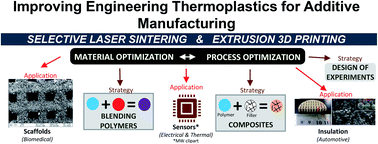Recent advances in additive manufacturing of engineering thermoplastics: challenges and opportunities
Abstract
There are many limitations within three-dimensional (3D) printing that hinder its adaptation into industries such as biomedical, cosmetic, processing, automotive, aerospace, and electronics. The disadvantages of 3D printing include the inability of parts to function in weight-bearing applications, reduced mechanical performance from anisotropic properties of printed products, and limited intrinsic material performances such as flame retardancy, thermal stability, and/or electrical conductivity. Many of these shortcomings have prevented the adaptation of 3D printing into product development, especially with few novel researched materials being sold commercially. In many cases, high-performance engineering thermoplastics (ET) provide a basis for increased thermal and mechanical performances to address the shortcomings or limitations of both selective laser sintering and extrusion 3D printing. The first strategy to combat these limitations is to fabricate blends or composites. Novel printing materials have been implemented to reduce anisotropic properties and losses in strength. Additives such as flame retardants generate robust materials with V0 flame retardancy ratings, and compatibilizers can improve thermal or dimensional stability. To serve the electronic industry better, the addition of carbon black at only 4 wt%, to an ET matrix has been found to improve the electrical conductivity by five times the magnitude. Surface modifications such as photopolymerization have improved the usability of ET in automotive applications, whereas the dynamic chemical processes increased the biocompatibility of ET for medical device materials. Thermal resistant foam from polyamide 12 and fly ash spheres were researched and fabricated as possible insulation materials for automotive industries. These works and others have not only generated great potential for additive manufacturing technologies, but also provided solutions to critical challenges of 3D printing.

- This article is part of the themed collection: 2020 Reviews in RSC Advances


 Please wait while we load your content...
Please wait while we load your content...